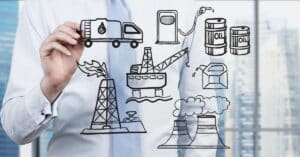Humankind has long known the damage we are doing to our environment. But as warnings become increasingly severe, species under threat from climate change now includes even us.
To slow down the potential harm, we are constantly advised to reduce our carbon footprint – and this also affects the way we run our businesses.
What is a carbon footprint?
Carbon is known as the chemical backbone of life. It’s found in rocks, in the seas, air and in living organisms. It regulates the Earth’s temperature and provides the energy we need for modern living.
But too much carbon dioxide is causing damage to our atmosphere, leading to what is commonly understood as climate change. High concentrations of carbon dioxide are mainly caused by the fossil fuels we burn for energy.
The accumulation of greenhouse gases we generate through a range of activities that have become a normal part of our lives is known as the carbon footprint. Most of us around the globe have an average carbon footprint of around 4 tonnes, which is higher in developed nations like the US. To avoid a 2°C rise in global temperature, the average carbon footprint needs to reduce to less than 2 tonnes by 2050.
By changing what we eat, our buying choices, how we travel and how we use energy, we can each drastically cut our individual carbon footprints.
Less is understood about how businesses can reduce their carbon footprint – unless you produce high emissions, create vast amounts of waste or transport goods across long distances.
What is carbon offsetting?
Carbon offsetting means reducing or removing emissions of carbon dioxide and/or other greenhouse gases from the atmosphere and using “carbon credits” to compensate for emissions made somewhere else. Essentially, you can “offset” them with more sustainable methods of production, which counter for emissions made elsewhere.
It is no longer enough for businesses to pollute our air, land, seas and cities while promising to plant a few trees to make up for it. With the Earth at crisis point, much more needs to be done.
Now is not the time for greenwashing!
A truly modern, forward-thinking business needs to think sustainably. Any business strategy must include policies to neutralise carbon emitted by activities such as production and transport.
Think this only includes companies making candles from hemp or tie-dye clothing?
According to figures from October 2020, 163 companies from the Fortune Global 500 had publicly committed to achieving climate-related targets. Carbon neutrality was the most common of these, cited by 91 companies.
With the UK government increasing environment-related legislation, such as its net zero target, short-sighted businesses ignore this peril – and could soon be left behind.
How does a business do carbon offsetting?
Firstly, whether you’re a sustainability manager or a CEO, you’re not alone.
Carbon offsetting can seem like a daunting challenge, but these days it’s becoming such a necessity that there is a wealth of help available for businesses.
And don’t try to go it alone either – your colleagues and employees are vital in making a real difference that will not only bring success, but will have a lasting and increasing positive impact on both the environment and your business.
- Find the problems: Starting with an environmental audit enables a business to identify what the issues are and also the best teams and people to help find solutions.
- Employee buy-in is essential: Everyone must work together to reduce emissions, reduce waste and find ways to make a positive impact on the environment as opposed to harm. Encouraging them to share their knowledge with others is a smart way to distribute responsibility for carbon offsetting throughout the organisation, instead of holding one or two people accountable.
- Upskilling your workers with green skills: At TSW, we offer a range of IEMA courses that effectively train all levels staff for the challenges climate changes poses for your business. These include opportunities to gain the knowledge you need to prepare not just for changes happening now, but those that could happen in the future – and the changes in law that could accompany them.
What are the challenges?
Some measures may prove costly at first, such as reviewing processes and making changes, such as sourcing alternative materials, production and transport methods, or taking direct action to tackle emissions. However, the long-term rewards will definitely be worth it.
What are the benefits?
For a start, the business is more likely to survive and avoid penalties incurred by ignoring changes in legislation. Your employees will be more engaged, working together to make a positive impact on the environment.
Overall, a happier workforce and more streamlined processes will improve the company’s profile among customers, make it more competitive and maybe even increase profitability.







